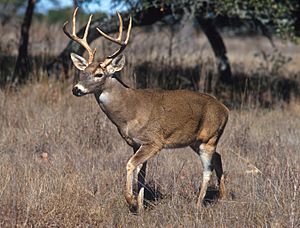Wildlife management facts for kids

Wildlife management is a general term for the process of keeping wild species at desirable levels as determined by wildlife managers. Wildlife management can include game keeping, wildlife conservation and pest control. Wildlife management has become an integrated science using disciplines such as mathematics, chemistry, biology, ecology, climatology and geography to gain the best results.
Wildlife conservation aims to halt the loss of species. It does this by taking using ecological principles to balance the needs of wildlife with the needs of people. Most wildlife is concerned with the preservation and improvement of habitats. Techniques can include reforestation, pest control, irrigation, coppicing and hedge laying.
Game keeping is the management or control of wildlife for the wellbeing of game birds. It may include killing other animals which share the same niche or predators to maintain a high population of the more profitable species, such as pheasants introduced into woodland. In his 1933 book Game Management, Aldo Leopold, one of the pioneers of wildlife management as a science, defined it as "the art of making land produce sustained annual crops of wild game for recreational use".
Images for kids
-
Han dynasty tomb brick depicting a fishing and hunting scene
See also
 In Spanish: Manejo de la vida silvestre para niños
In Spanish: Manejo de la vida silvestre para niños



